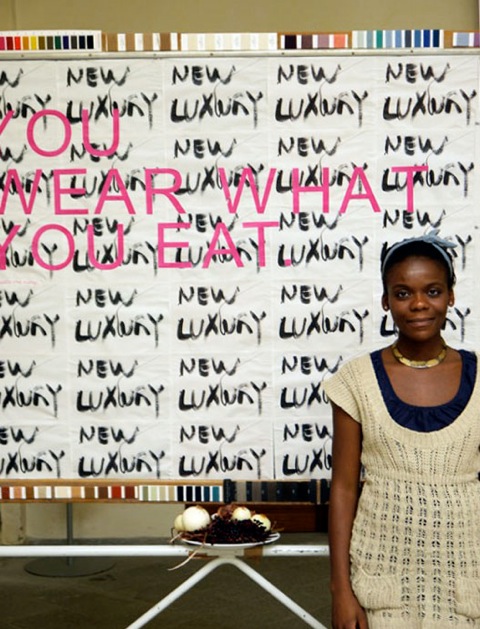Last spring I was invited to participate in Cittadellarte’s (City of Art) University of Ideas (UNIDEE) thanks to a grant from Fondazione Zegna. I was eager to examine sustainability in the context of the Italian luxury fashion industry and I am pleased to share a two-part post about my experiences. This second installment of my Contextualizing Sustainability series looks at sustainability through the lens of my NEW LUXURY work. If you missed the first post in the series, The Fourth Bottom Line, read it now.
NEW LUXURY is part installation, part magazine, part documentary film. It is an ongoing, global project currently in exhibition at Cittadellarte-Fondazione Pistoletto. The exhibition showcases l’anteprima, or preview issue, which is displayed in a magazine format on the wall that is engraved with the project title and motto. The relief work was done using an electric saw and chisel and hammer.
Contextualizing sustainability: wear what you eat
My UNIDEE project, “NEW LUXURY: the equalization of sustainability and luxury in the Italian fashion industry” advocates for this type of coalescence between what are seemingly conflicting concepts. The luxury goods industry is based on the ability to appeal to consumer aspiration. Perhaps the genius of Zegna is that its model for social, environmental and economic accountability is as well anchored as the plant life decorating the 26 kilometer Zegna panoramic route- a garden for the people. The culture of sustainability is inspired by the sustenance of a family and its extended relatives- the factory workers and thousands of other employees, the Biellese community, and the exclusive clientele around the world. The consumer unconsciously equates sustainability with luxury. He aspires to own a beautifully tailored suit and is inadvertently integrated into the Zegna family, just as Ermenegildo Zegna intended a century ago. Don’t bother searching for the company’s CSR division, “We don’t have one”, Anna explained to me. The ethical fiber of Zegna is deeply embedded across the board, much like one would expect morals to disperse and be shared amongst a close-knit family.
Criteria for sustainability compliance
By identifying the motives behind the values and methods implemented into the corporate agendas of leading Italian fashion houses, we can begin to understand how to administer criteria for sustainability compliance. It is indeed necessary to identify the benefits of compliance in order to elevate to a heightened level of commitment to responsible corporate governance. By identifying the true economic cost and value of sustainability we can transcend a debate focused on idealisms and begin to analyze and understand industry perceptions of sustainability and strategize in favor of successful CSR implementation. Fondazione Zegna, established in 2000, has been able to extend its philanthropic arm over the years because it has identified the worth of its goods and services abroad which promote sustainability. This indulgence of the family’s passion for humanitarian and environmental improvement is a reflection of the cyclical nature of system management, system dependencies and system relationships. Work in developing and emerging markets, such as India and Peru, includes unwavering support of Care and Share India and Ermenegilda Zegna’s participation in the International Vicuña Consortium which protects the endangered Peruvian camelidae specie.
It is true that what motivates the Italian business owner is very different than what motivates the American business owner due to value systems embedded within two very distinct cultural psyches, however, economic value is a ubiquitous affection. Now is the opportune time to further investigate the financial benefits of responsible production and to explore how best to address challenges in distinct cultural settings. This is a direct path to decreasing greenwashing, essentially reformulating the current dialogue from an emotional one where sustainability sits in a vulnerable and uncertain position, to a practical one worthy of executive attention. At a time when many corporate leaders are scurrying to comply with government regulations and answer to consumer concerns Zegna leads with exemplary action by working alongside government and local communities in Peru.
A universal definition and application of sustainability best practices is bound to alienate one culture or another because it fails to place importance on diverse cultural infrastructures that are composed of individual people. Sustainability advocates tugging at the coattails of big companies should continue to defend environmental stewardship, social engagement and economic benefits enjoyed by greater society while bearing in mind a fourth component- culture vitality. Negating the existence of different strands of “cultural DNA” that could make luxury consumers feel recognized as being different and proud of their heritage could instead backfire and diminish their impulse to “do good”, or in this case shop responsibly. Before we twist a man’s arm, we must understand where that man comes from, thus making the best choices for our planet, its people, and the economy.
Ibada Wadud (article author) has taken online Sustainable Design classes at MCAD. Ibada returned to the US after a summer in Italy making productive steps to fulfill her mission to create an ethical fashion industry. Top image courtesy of @Margarita Vázquez Ponte. All other images courtesy of @Ángel Masip.


